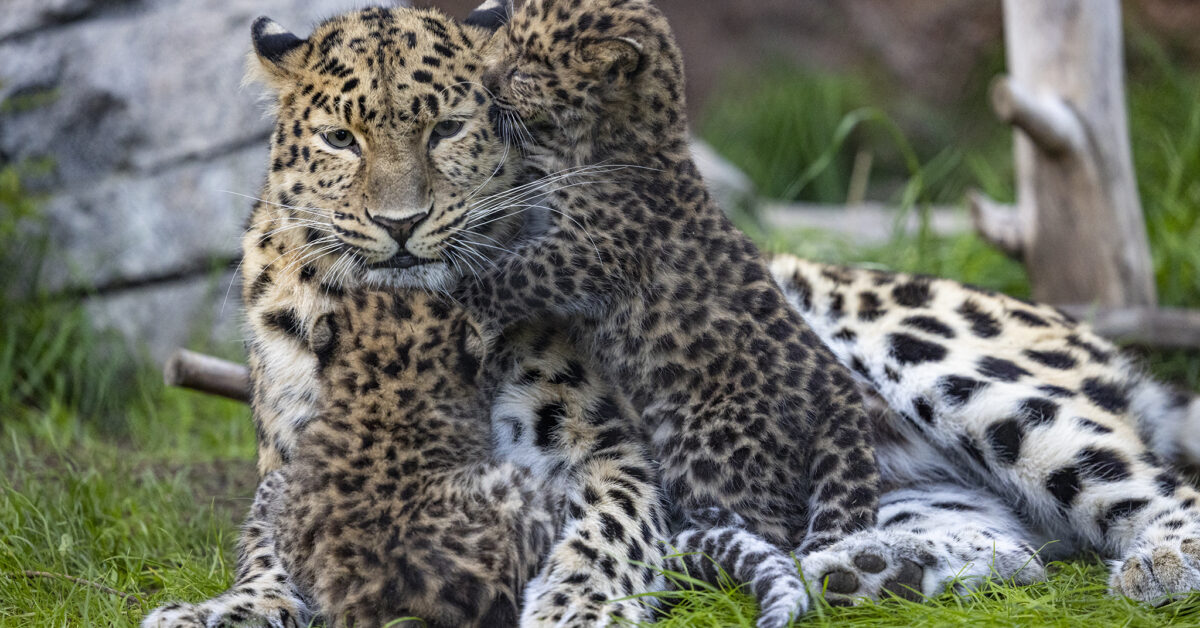Summary of Fur-miliar Faces – San Diego Zoo Wildlife Alliance Stories:
The article discusses the growth and development of two Amur leopard siblings, Ulybka and Zorinka, at the San Diego Zoo. Born in February 2023 to their mother Satka, the cubs have been learning essential survival skills and behaviors emblematic of their species. Ulybka, named after the Russian word for “smile,” has a dark coat and a distinctive smile-like marking on her forehead. Zorinka, meaning “little star,” has lighter fur and more blurred markings. Initially needing close care due to their vulnerability, they’ve grown more independent, now nearly the size of their mother and displaying keen interest and prowess in skills necessary for survival, such as pouncing, stalking, and exploring their environment. Their personalities have also emerged, with Zorinka being more solitary and Ulybka staying closer to their mother. Their development isn’t just playful; it’s part of a broader conservation effort to protect this critically endangered species, which numbers only around 100 in the wild. The siblings are seen as crucial to the global population’s survival. They are celebrated as hopeful symbols for the future of Amur leopards, with the zoo and its partners working to protect and restore their native ecosystems through the Asia Conservation Hub.
– The developmental stages and behaviors of Amur leopard cubs, Ulybka and Zorinka, showcased at the San Diego Zoo
– Importance of conservation efforts for the critically endangered Amur leopard species
– Role of zoos like the San Diego Zoo in wildlife conservation and education
– The significance of understanding animal behavior for conservation sciences
– The global impact of localized conservation efforts through collaborative projects like the Asia Conservation Hub
Exploring the formative years of Amur leopard cubs, Ulybka and Zorinka, at the San Diego Zoo reveals not only the critical stages of wild cat development but also serves as an invaluable educational tool in the broader context of wildlife conservation. Observing these siblings interact with their environment, and each other provides profound insights into these majestic animals’ innate behaviors and survival strategies. Their playful antics, from pouncing to exploring, are key components of their developmental journey, preparing them for adulthood and the challenges that come with it.
These cubs represent hope for their species, as the Amur leopard remains one of the world’s most critically endangered big cats, with an estimated wild population of merely a hundred individuals. This dire situation is largely due to human-induced pressures such as habitat loss, poaching, and climate change. Through the lens of Ulybka and Zorinka’s growth, we are reminded of the fragility of biodiversity and the importance of conservation efforts.
The San Diego Zoo serves as a pivotal platform for these conservation initiatives. Zoos play a multifaceted role in wildlife preservation, combining research, public education, and direct involvement in global conservation projects. Housing and caring for animals like Ulybka and Zorinka offer visitors a unique opportunity to connect with wildlife, fostering a deeper understanding and appreciation for the natural world. This connection is vital, as public support and awareness are the foundation for successful conservation efforts.
Understanding animal behavior is critical in the field of conservation science. Behaviors observed in zoo settings can often provide valuable data for wild animal research and conservation strategies. For instance, the feeding practices and hierarchical interactions witnessed among Amur leopard siblings can offer insights into their needs in wild habitats, guiding the development of more effective conservation programs. Furthermore, observing these leopards’ growth and development aids in perfecting captive breeding programs, a crucial element in species conservation.
The global impact of local conservation efforts is amplified through partnerships like the Asia Conservation Hub, as highlighted by the conservation work for the Amur leopard. Such collaborative efforts intertwine various organizations worldwide, pooling resources, knowledge, and expertise to tackle conservation challenges. This global network, supported by local initiatives and educational opportunities provided by zoos, underscores the interconnected nature of biodiversity conservation.
In essence, the stories of Ulybka and Zorinka at the San Diego Zoo embody the broader narrative of wildlife conservation. They illustrate how pivotal understanding animal behavior is to conservation efforts and the irreplaceable role zoos play in this domain. Similarly, they underscore the importance of global collaboration through initiatives such as the Asia Conservation Hub, reminding us that while conservation challenges are vast, the combined efforts of dedicated institutions and individuals can make a difference. Through engaging, educating, and inspiring the public, the San Diego Zoo Wildlife Alliance contributes significantly to the ongoing battle to save species like the Amur leopard from the brink of extinction, ensuring a brighter future for our planet’s biodiversity.


